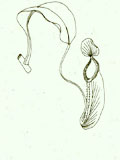
Invertebrates (pdf)
|
Sinthusa nasaka (Horsfield) (Lepidoptera: Lycaenidae), a butterfly new to Hong Kong |
|
A new record for Hong Kong and China of a Polistine wasp of the genus Ropalidia : Ropalidia mathematica (Vespidae: Polistinae: Ropalidiini) (pdf)
by Christophe Barthelemy
Project
Co-ordinator
Maitreya Project International
The eusocial wasp Ropalidia mathematica (Smith, 1860) has been recorded from various localities in Hong Kong by the author. This paper is a short description of this species. Ropalidia species are distinctive from other eusocial wasps by the petiolate 1st gastral segment, the fused and bulbous 2nd tergum and sternum. They are small insects, Ropalidia mathematica being the smallest of the three locally recorded species in that genus (R. fasciata, R. hongkongensis and R. mathematica), not exceeding 9.5 mm in length for workers (measurement is taken from the head to the apex of the 2nd gastral segment due to the collapse of the following segments). Males and queens have not yet been recorded. The coloration is lighter than the other two Ropalidia species and the wasp is somewhat maculated with black rufuous and yellow markings (Fig. 1-3).
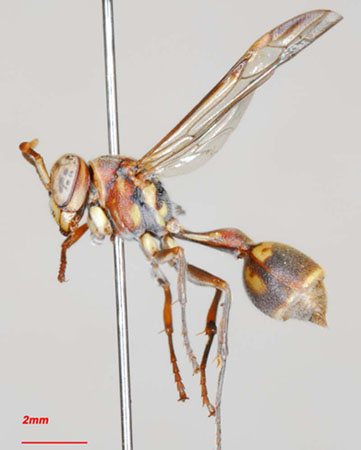 |
| Fig. 1. Lateral view of a Ropalidia mathematica worker. |
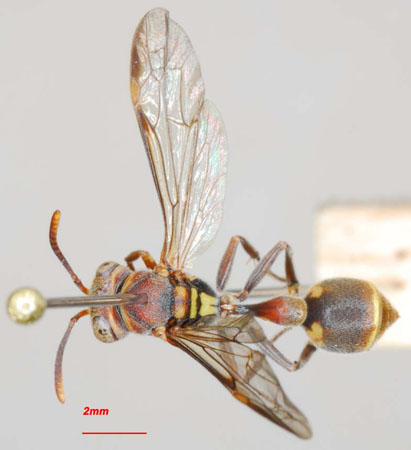 |
| Fig. 2. Dorsal view of a Ropalidia mathematica worker. |
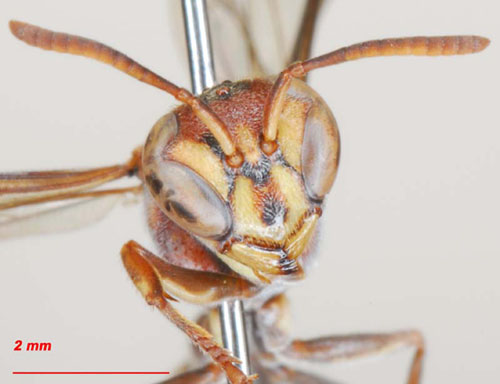 |
| Fig. 3. Head view of a Ropalidia mathematica worker. |
This wasp is actually widespread in South East Asia and it is quite surprising that it had never been recorded for Hong Kong or China previously, possibly due to its reduced size and inconspicuous colors and habits. The known localities in SE Asia are (Nguyen et al, 2006): India (Meghalaya); Thailand, Vietnam, Sumatra; Java; Bali; Sumbawa; Flores; Karimon; Djawa; Sunda Straits; Sulawesi, Lombok, Flores; Sumba; Timor. In Hong Kong this species has been recorded from Kornhill (HK Island) and Pak Sha O (Sai Kung Country Park), although it is possibly wide spread across the territory.
One colony was discovered at the end of June 2006 hanging from climbers in a Ficus tree. It was situated approximately 3 m off the ground and contained four to five individuals. The drop-shaped single comb is typical of this species. It is attached to the substrate by a single pedicel (Fig. 4). The comb contained a full brood, from eggs situated at the bottom to mature larvae placed at the top. Although Ropalidia species are known to apply an ant repellant to the petiole (Gadagkar, 1991), this has not been confirmed with R. mathematica in Hong Kong. Additionally the pedicel may be imbibed with the substance but it seems to be too short to offer a real protection against ants. The cells are un-specialised, i.e. there is no difference in size for workers, queens and males. The nest material is essentially composed of loosely woven glandular secretions leaving numerous "windows".
The colonies in Hong Kong are founded towards the end of March and April. Although a number of species of Ropalidia are known to have multiple foundresses (Gadagkar, 1991), this is not demonstrated locally and most of the Polistine colonies studied to date locally are in fact founded by a single queen (pers.obs. unpubl.). The colonies develop all through the summer and finally die off at the onset of autumn. Males of Ropalidia are produced throughout the colony cycle or at least after the emergence of the 1st workers. This is quite unique in the Polistine subfamily which generally produces males towards the end of the colony cycle. The colonies are most probably reduced in size, never having more than ten to twenty workers, as is the case within the Stigma group to which R. mathematica belongs (Spradbery, 1991). As with all other species of Ropalidia, R. mathematica extracts the meconium (larvae faeces) at the end of the larval development, just before pupation, by creating a hole at the end of the cell, later plugged by the workers for pupation. The dominance hierarchy is not known for R. mathematica, but most probably the queen maintains her dominant status by active aggression and disturbing any attempt by other females to lay eggs. Pheromone control is not proven in most Polistine wasps.
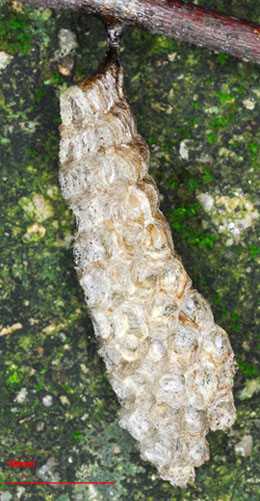 |
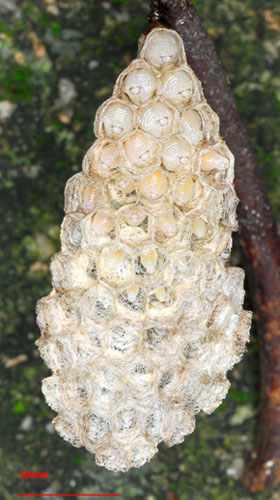 |
| Fig. 4. (left) Lateral view of a Ropalidia mathematica nest at initiation stage. No worker has yet emerged. Note the single pedicel and (right) frontal view of a Ropalidia mathematica nest. Note the large larvae at the top of the nest. | |
The particular food provision of R. mathematica is not known locally but it is assumed that this wasp preys on a variety of small caterpillars as a proteinaceous food source for the larvae. Carbohydrates are most certainly provided through plant nectars and sap and possibly honeydew from various Sternorrhyncha. The particular diet of adults is not known and in general this remains relatively unknown for most Vespidae (Hunt, 1991).
Although direct predation of nests of R. mathematica has not been observed locally, Polistine colonies often fall prey to larger Vespids particularly Vespa tropica, V. ducalis and V. soror.
References
Gadagkar, R. (1991). Belonogaster, Mischocyttarus, Parapolybia and Independent-founding Ropalidia. In: The Social Biology of Wasps, (eds. K.G. Ross & R.W. Mattews), Cornell University Press.
Hunt, J.H.(1991). Nourishment and the Evolution of the Social Vespidae. In: The Social Biology of Wasps, (eds. K.G. Ross & R.W. Mattews), Cornell University Press.
Ngyuen, L.T.P., Kojima, J., Saito, F. & Carpenter, M. (2006). Vespidae of Vietnam (3): Synoptic key to Vietnamese species of the polistine genus Ropalidia, with notes on taxonomy and distribution. Entomological Science 9:93-107. The Entomological Society of Japan.
Spradbery, J.P. (1991). Evolution of Queen Number and Queen Control. In: The Social Biology of Wasps (eds. K.G. Ross & R.W. Mattews), Cornell University Press.
P.8-10
|
Porcupine! |
 Copyright © 2000 |
